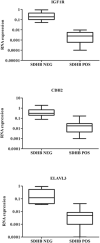Overexpression of insulin-like growth factor 1 receptor and frequent mutational inactivation of SDHA in wild-type SDHB-negative gastrointestinal stromal tumors
- PMID: 23109135
- PMCID: PMC3564228
- DOI: 10.1002/gcc.22023
Overexpression of insulin-like growth factor 1 receptor and frequent mutational inactivation of SDHA in wild-type SDHB-negative gastrointestinal stromal tumors
Abstract
Approximately 15% of gastrointestinal stromal tumors (GISTs) in adults and 85% in children lack mutations in KIT and PDGFRA and are known as wild-type GISTs. Wild-type GISTs from adults and children express high levels of insulin-like growth factor 1 receptor (IGF1R) and exhibit stable genomes compared to mutant GISTs. Pediatric wild-type GISTs, GISTs from the multitumor Carney-Stratakis syndrome, and the Carney triad share other clinicopathological properties (e.g., early-onset, multifocal GISTs with epitheliod cell morphology), suggesting a common etiology. Carney-Stratakis is an inherited association of GIST and paragangliomas caused by germline mutations in succinate dehydrogenase (SDH) genes. The connection between defective cellular respiration and GIST pathology has been strengthened by the utilization of SDHB immunohistochemistry to identify SDH deficiency in pediatric GISTs, syndromic GISTs, and some adult wild-type GISTs. SDHB and IGF1R expression was examined in 12 wild-type and 12 mutant GIST cases. Wild-type GISTs were screened for coding-region alterations in SDH genes and for chromosomal aberrations using genome-wide single-nucleotide polymorphism and MIP arrays. SDHB-deficiency, identified in 11/12 wild-type GIST cases, was tightly associated with overexpression of IGF1R protein and transcript. Biallelic inactivation of the SDHA gene was a surprisingly frequent event, identified in 5 of 11 SDHB-negative cases, generally due to germline point mutations accompanied by somatic SDHA allelic losses. As a novel finding, inactivation of the SDHC gene from a combination of a heterozygous coding-region mutation and hypermethylation of the wild-type allele was found in one SDHB-negative case.
Copyright © 2012 Wiley Periodicals, Inc.
Figures




References
-
- Absalan F, Ronaghi M. Molecular inversion probe assay. Methods Mol Biol. 2007;396:315–330. - PubMed
-
- Agaimy A, Terracciano LM, Dirnhofer S, Tornillo L, Foerster A, Hartmann A, Bihl MP. V600E BRAF mutations are alternative early molecular events in a subset of KIT/PDGFRA wild-type gastrointestinal stromal tumours. J Clin Pathol. 2009;62:613–616. - PubMed
Publication types
MeSH terms
Substances
Grants and funding
LinkOut - more resources
Full Text Sources
Research Materials
Miscellaneous

